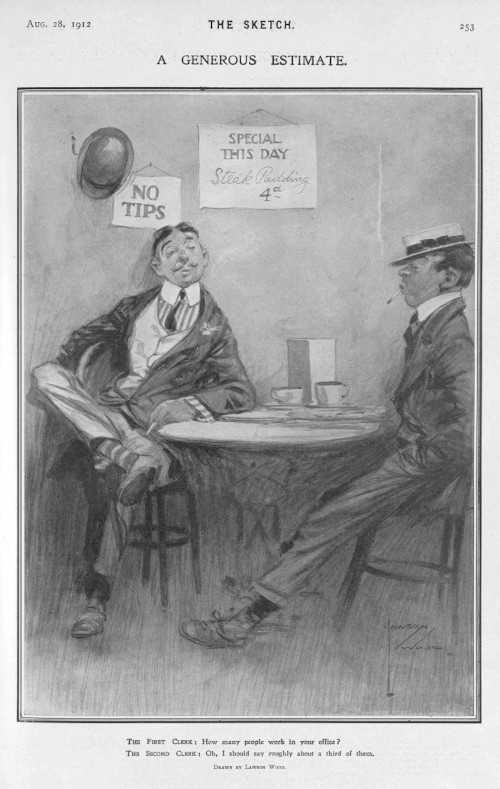Charles M. Schwab? Reed Smoot? Pope John XXIII? Fliegende Blätter? Edgar Wallace? Anonymous?

Question for Quote Investigator: A visitor to a large business watched as numerous workers moved purposefully along the hallways into offices. The visitor approached the leader of the company and asked:
“This is such a busy place! How many people work here?”
The leader pondered the question carefully and replied:
“I would guess about forty percent.”
I have heard many versions of this joke. In one instance, the location was Vatican City, and the punchline was spoken by the Pope. Would you please explore this topic?
Reply from Quote Investigator: This anecdote is part of a large evolving family of tales. The ratio of workers to non-workers varies. The earliest evidence known to QI appeared in the popular German humor magazine “Fliegende Blätter” in 1907. Boldface added to excerpts by QI:1
Mißverstanden
„Wieviel Leute sind denn bei Euch im Bureau tätig?“ —
„Tätig? Na — zwei Drittel!“
The issue containing the joke was undated, but it was the eighth weekly issue of 1907, so it probably appeared around late February.
The first instance in English located by QI appeared in the New York magazine “Transatlantic Tales” within a filler item titled “Misunderstood”. The German source was acknowledged. Boldface added to excerpts by QI:2
Misunderstood
“How many people work in your office?”
“Work? Perhaps two-thirds of them.”
—Translated for Transatlantic Tales from “Fliegende Blätter.”
The cover date of “Transatlantic Tales” was November 1907, but the issue was available before the cover date. A newspaper in Harrisburg, Pennsylvania published a matching joke on October 19, 1907 while acknowledging “Transatlantic Tales” and noting that the original source was “Fliegende Blaetter”.3 The word “Blaetter” was an alternative spelling of “Blätter”.
Below are additional selected citations in chronological order.
This filler item was reprinted with the same acknowledgement in numerous papers, e.g., “The Fort Wayne Journal-Gazette” of Indiana4 and “The Sunday State Journal” of Lincoln, Nebraska5
In 1908 the New York humor magazine “Life” printed the joke while crediting the same German magazine.6
In 1909 the “Toronto Saturday Night” newspaper of Canada published an expanded anecdote with the same punchline:7
The other-people’s-business man persisted in trying to extract information from a prosperous looking elderly man next him in the Pullman smoker.
“How many people work in your office?” he asked.
“Oh,” said the elderly man, getting up and throwing away his cigar, “I should say, at a rough guess, about two-thirds of them.”
In August 1912 “The Sketch” of London printed a one-panel cartoon titled “A Generous Estimate” drawn by Lawson Wood depicting two clerks. The punchline of the joke used the ratio of one-third instead of two-thirds:8
The First Clerk: How many people work in your office?
The Second Clerk: Oh, I should say roughly about a third of them.

Some U.S. periodicals reprinted the dialog above without the cartoon. For example, in December 1912 “The Tradesman” of Chattanooga, Tennessee shared the jest with its readers while acknowledging “The Sketch”.9
In 1913 the “Wells Fargo Messenger” of New York published another version of the anecdote that specified a ratio of one-half:10
Last week I asked a manufacturer, “How many people work in your offices?” He replied, somewhat sarcastically, “About half of them.”
In 1914 the book “300 Latest Stories by 300 Famous Story Tellers” included two similar versions of the gag. One was told by U.S. politician Reed Smoot, and the other was told by a business magnate:11
CHARLES M. SCHWAB tells a story about a type of a man he often meets, the sort he calls the “other-people’s business-man.”
“I overheard a conversation between one of these men and a large, prosperous-looking gentleman. It was in a smoking-car. They were sitting together.
“After a few puffs of his cigar the inquisitive man inquired of his neighbour, ‘How many people work in your office?’
“The prosperous-looking gentleman slowly bit the end off of a fresh cigar, and buried himself in his paper as he replied: ‘At a rough estimate I should say about two-thirds of them.'”
In 1934 columnist Bert Levy presented a tale set in Hollywood, and he credited the punchline to English author and screenwriter Edgar Wallace:12
I was standing outside the main entrance of the Fox Art Hills Studios talking with the late Edgar Wallace. We were both without hats, and a party of Hollywood sightseers came along, and mistaking us for a couple of officials of the studio, one of then addressing Mr. Wallace, asked politely, “Do many people work here?” Edgar scratched his head for a moment, and then answered politely, “Well—er—about one-third of them.”
In 1939 a correspondent of “The Birmingham Post” assigned the punchline to a staff member at the League of Nations:13
The Secretariat loves a joke, especially one at its own expense. An American visitor in the old easy-going days once contemplated the League building and asked a member of the staff “How many people work here?” “Oh,” was the reply, “about 40 per cent.” Nowadays the answer would be: “Everybody, a full day’s work—and then some.”
In 1959 “The Sacramento Bee” reported that Bishop Joseph T. McGucken of Sacramento, California visited Vatican City and spoke with Pope John XXIII:14
The bishop was impressed by a large retinue of workers in the Vatican.
“How many people work here?” he asked the pope.
“About half of them” the pope replied.
In conclusion, this quip entered circulation by 1907. It appeared in the German humor magazine “Fliegende Blätter” in late February of 1907. Hence, the creator may have been a staff member or correspondent of “Fliegende Blätter”. Next, it appeared in English within “Transatlantic Tales” and U.S. newspapers in October 1907. The German source received acknowledgment. Over time a wide variety of anecdotes have evolved which contain instances of the punchline.
Image Notes: Image of St. Peter’s Basilica in the Vatican City and St. Peter’s Square by Giovanni Battista Piranesi. Image has been cropped, retouched, and resized.
Acknowledgement: Many thanks to Joe Stynes, Daniel Rentzsch, and Peter Reitan who searched for the German version of the joke based on the acknowledgement information provided in “Transatlantic Tales”. The search concluded successfully. Also thanks to Dan Goncharoff and Joe Stynes for estimating the publication date in “Fliegende Blätter”. Great thanks to Eccles whose inquiry led QI to formulate this question and perform this exploration. In addition, thanks to Barry Popik for his helpful research. Popik located multiple instances of the joke beginning in 1918 together with a 1963 version with the punchline attributed to the Pope.
Update History: On August 27, 2020 the citation for “Transatlantic Tales” was added. On August 28, 2020 the citation for “Fliegende Blätter” was added. On March 27, 2025 the format of the bibliographical notes was updated.
- 1907, Fliegende Blätter, Volume 126, Number 3213, Mißverstanden, Quote Page 92, Verlag Braun & Schneider, Munich, Germany. (Heidelberg historic literature – digitized; Access via digi.ub.uni-heidelberg.de) link ↩︎
- 1907 November, Transatlantic Tales, Volume 37, Number 1, Misunderstood (Filler item), Quote Page 97, Ess Ess Publishing Company, New York. (Google Books Full View) link ↩︎
- 1907 October 19, The Star-Independent, Misunderstood (Filler item), Quote Page 9, Column 7, Harrisburg, Pennsylvania. (Newspapers_com) ↩︎
- 1907 October 20, The Fort Wayne Journal-Gazette, Misunderstood (Filler item), Quote Page 7, Column 7, Fort Wayne, Indiana. (Newspapers_com) ↩︎
- 1907 October 20, The Sunday State Journal, Misunderstood (Filler item), Quote Page 5, Column 4, Lincoln, Nebraska. (Newspapers_com) ↩︎
- 1908 May 7, Life, Volume 51, Aut Scissors Aut Nullus, Quote Page 500, Life Publishing Company, New York. (Google Books Full View) link ↩︎
- 1909 February 13, Toronto Saturday Night, Anecdotal, Quote Page 16, Column 3, Toronto, Ontario, Canada. (British Newspaper Archive) ↩︎
- 1912 August 28, The Sketch, A Generous Estimate (Single Panel Cartoon drawn by Lawson Wood), Quote Page 253 (25), London, England. (British Newspaper Archive) ↩︎
- 1912 December 19, The Tradesman: The South’s Authoritative Industrial Trade Journal, Volume 68, Number 25, Some Good Stories Briefly Related in a Lighter Vein: The Proper Ratio, Quote Page 50, Column 2, Chattanooga, Tennessee. (Google Books Full View) link ↩︎
- 1913 July, Wells Fargo Messenger, Volume 1, Number 11, Under the Head of New Business by Herbert N. Casson, Start Page 169, Quote Page 170, Column 1 and 2, Wells Fargo and Company, New York. (Google Books Full View) link ↩︎
- 1914, 300 Latest Stories by 300 Famous Story Tellers as told by Marshall P. Wilder, O. Henry, George M. Cohan, Chauncey M. Depew, and others, Section: Charles M. Schwab, (Also: Section: Senator Reed Smoot, Quote Page 111), Quote Page 176, Star Library Company, New York. (Google Books Full View) ↩︎
- 1934 August 23, The Stage, Hollywood Notes by Bert Levy, Quote Page 10, Column 4, London, England. (Newspapers_com) ↩︎
- 1939 May 22, The Birmingham Post, Financial Position of the League: British Empire’s Big Contribution, Quote Page 7, Column 6, Birmingham, Warwickshire, England. (British Newspaper Archive) ↩︎
- 1959 October 19, The Sacramento Bee, Bishop McGucken Finds Pope To Be Man of Wisdom, Humor by A. E. Lyons, Quote Page C1, Column 3, Sacramento, California. (Newspapers_com) ↩︎